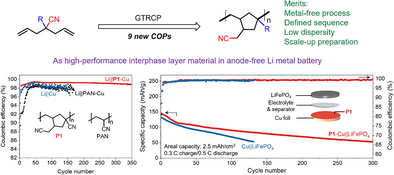Preparation of Cyclic Olefin Polymers via Group Transfer Radical Cyclopolymerization for High Performance in Anode-Free Batteries
Dedicated to the 5th anniversary of the Frontiers Science Center for Transformative Molecules
Graphical Abstract
An innovative group transfer radical cyclopolymerization (GTRCP) method has been developed for the precise synthesis of functionalized cyclic olefin polymers (COPs) using non-conjugated diene monomers. Through rational monomer design, various polar groups are incorporated into the COP backbones. The resulting polymers exhibit high molecular weights, low dispersities, controllable chain sequences, and high structural diversity. The polymer can function as a robust interphase layer, enhancing the reversibility of lithium plating/stripping in anode-free lithium metal batteries.
Abstract
Cyclic olefin polymers (COPs) are of high importance in optical and medical materials. These materials are typically synthesized via ring-opening metathesis polymerization of norbornene derivatives, using metallocene catalysts, followed by high-pressure hydrogenation catalyzed by noble metals. However, the complex synthetic processes, the continuous use of expensive catalysts, and the need to remove metal residues remain substantial barriers in COP production. In contrast, radical cyclopolymerization of dienes, which eliminates the need for metal catalysis and hydrogenation, offers a promising alternative for COP synthesis. Nevertheless, chain transfer reactions hinder the radical polymerization of non-conjugated dienes. To address these challenges, we present a novel strategy, group transfer radical cyclopolymerization (GTRCP), which effectively suppresses chain transfer and enables radical polymerization of dienes to yield COPs. This approach allows for the production of a broad range of sequence-regulated COPs with high molecular weights and low dispersity. Density functional theory calculations support the proposed GTRCP mechanism, highlighting its efficiency and selectivity, driven by substantial thermodynamic forces. The resulting COPs demonstrate great potential as the interphase layer materials in anode-free lithium metal batteries, significantly enhancing the cycling performance towards practical energy storage applications.
Conflict of Interests
C.Z., Y.C., and X.W. are inventors on patent application (CN202311398744.9) held/submitted by Shanghai Jiao Tong University. All other authors declare that they have no competing interests.
Open Research
Data Availability Statement
The data that support the findings of this study are available from the corresponding author upon reasonable request.





